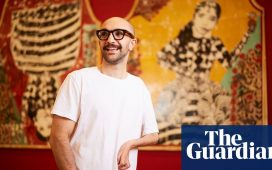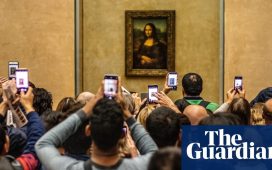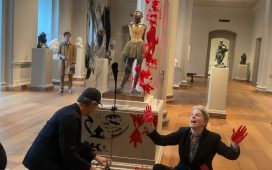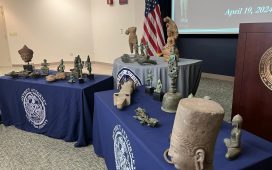Van Gogh had an astonishing visual sensibility and memory. Although lacking conventional artistic training, he did not become an artist in isolation—he was inspired by earlier painters and those of his own generation. But rather than slavishly following them, he took what appealed to him and forged his own unique style. That was his great achievement.
Steven Naifeh’s book, Van Gogh and the Artists He Loved, to be published next week, highlights works that were to prove an inspiration. For instance, Vincent was a great admirer of Japanese prints. While living in Paris, he painted his personal homage to Utagawa Hiroshige—creating an interpretation of Flowering Plum Trees at Kameido and adding borders of unrelated Japanese characters borrowed from another print.
When Vincent painted a still life of his rustic chair in the Yellow House in Arles, he described it as “my own empty chair”. This idea was taken from a magazine illustration by the English artist Luke Fildes, which he had seen in a back issue of The Graphic some seven years earlier. Fildes had depicted the empty chair of Charles Dickens, immediately after the writer’s death in 1870.
Luke Fildes’ The Empty Chair, The Graphic, Christmas 1870 and Van Gogh’s Chair (December 1888-January 1889) Fildes: Van Gogh Museum, Amsterdam (Vincent van Gogh Foundation); Van Gogh: National Gallery, London
Van Gogh also took inspiration from the work of his contemporaries. Louis Anquetin was a younger artist whom Vincent knew in Paris. Although now largely forgotten, in the late 1880s Anquetin was in the vanguard in terms of style. His Avenue de Clichy (1887) must surely have been in Van Gogh’s mind when the following year, in Arles, the Dutchman embarked on Terrace of a Café at Night.
Louis Anquetin’s Avenue de Clichy (Five O’clock in the Evening) (1887) and Van Gogh’s Terrace of a Café at Night (Place du Forum) (September 1888) Anquetin: Wadsworth Atheneum Museum of Art, Hartford, Connecticut (Ella Gallup Sumner and Mary Catlin Sumner Collection Fund, 1966.7); Van Gogh: Kröller-Müller Museum, Otterlo
The links in these three pairs of works have long been recognised, but Naifeh digs deeper in his book. For example, he suggests that Van Gogh was thinking of Jacob Maris’ watercolour Two Girls at the Piano, which he had noted in an 1881 exhibition, when nine years later he painted Marguerite Gachet at the Piano. In both cases the player’s right hand is very similar. However, female pianists were a popular motif in late 19th century art—so perhaps a direct link is not entirely clear.
Jacob Maris’ Two Girls at the Piano (about 1880) and Van Gogh’s Marguerite Gachet at the Piano (June 1890) Maris: Rijksmuseum, Amsterdam; Van Gogh: Kunstmuseum Basel (photo: Martin P. Bühler)
Van Gogh and the Artists He Loved is a profusely illustrated musée imaginaire, representing Vincent’s ideal museum. It is a volume which the artist would have loved to have had by his bedside table.
Naifeh, along with his companion the late Gregory White Smith, was the co-author of the 2011 best-selling biography Van Gogh: the Life—so he draws upon great accumulated knowledge.
What may come as a surprise is that Naifeh is not only a writer, but also a collector. In a very personal account at the end of his latest book he explains how he and Smith bought Joye Cottage—its name belies the fact that the 60-room Gilded Age mansion is the largest private home in South Carolina. In 2000 they began “collecting art for the great number of walls in our sprawling but rather empty house”.
By this time they were beginning work on their biography, so the idea then emerged of buying art by artists linked with Van Gogh. For their collection, it would have too limiting (and expensive) to go for specific works that influenced Vincent, so instead they went for artists he admired. Where possible, they sought out paintings with a similar subject matter.
Examples include two pictures that they bought by the Impressionist Armand Guillaumin. The still lifes of oleanders by Guillaumin and Van Gogh date 15 years apart, but the two wheatfield landscapes by them were both done within a month of each other and were painted in villages just outside Paris.
Armand Guillaumin’s Still-life with a Blue Box (around 1873) and Van Gogh’s Oleanders (August 1888) Guillaumin: Gregory White Smith and Steven Naifeh (photo: Glenn Castellano); Van Gogh: Metropolitan Museum of Art, New York
Armand Guillaumin’s Breuillet (August 1890) and Van Gogh’s Sheaves of Wheat (July 1890) Guillaumin: Gregory White Smith and Steven Naifeh (photo: Glenn Castellano); Van Gogh: Dallas Museum of Art (Wendy and Emery Reves Collection)
Although Guillaumin and Van Gogh were in contact with each other, sharing a common interest in striving for “modern” art, their styles are rather different. Seeing their works together emphasises quite how dramatically Vincent was pushing ahead.
Van Gogh was always open in acknowledging his artistic debts—and realised that others might follow him. In 1888, when he was working in Provence, Vincent wrote to his brother Theo saying that the painters of the future would “walk in our footsteps”. He then added: “Life is short, though, and especially the number of years when one feels strong enough to brave everything.”
The publication of Naifeh’s book coincides with an exhibition that he has co-curated at the Columbus Museum of Art in Ohio: Through Vincent’s Eyes: Van Gogh and his Sources, which will open on 12 November. But more about that in a future blog post.
The cover of Steven Naifeh’s Van Gogh and the Artists He Loved, to be published by Random House on 2 November
Other Van Gogh news
- The exhibition In the Eyes of Van Gogh, at the Musée Félicien Rops in Namur, focuses on the artist’s links with Belgian artists. Loans of Van Gogh works presumably proved elusive since there is only a single example in the show: The Olive Trees of Montmajour, Arles (July 1888), a fine drawing on loan from Musée des Beaux-Arts, Tournai. Although in the Tournai collection since 1905, it was not published in the Van Gogh literature until the 1950s. The show, which has a good selection of works by late 19th- and early 20th-century Belgian artists, runs until 20 March 2022.
Van Gogh’s The Olive Trees of Montmajour, Arles (July 1888) Courtesy of the Musée des Beaux-Arts, Tournai (bequest of Henri Van Cutsem, 1904)
Martin Bailey is the author of Van Gogh’s Finale: Auvers and the Artist’s Rise to Fame (Francis Lincoln, 2021, available in the UK and US). He is a leading Van Gogh specialist and investigative reporter for The Art Newspaper. Bailey has curated Van Gogh exhibitions at the Barbican Art Gallery and Compton Verney/National Gallery of Scotland. He was a co-curator of Tate Britain’s The EY Exhibition: Van Gogh and Britain (27 March-11 August 2019).
Martin Bailey’s recent Van Gogh books
He has written a number of other bestselling books, including The Sunflowers Are Mine: the Story of Van Gogh’s Masterpiece (Frances Lincoln 2013, available in the UK and US), Studio of the South: Van Gogh in Provence (Frances Lincoln 2016, available in the UK and US) and Starry Night: Van Gogh at the Asylum (White Lion Publishing 2018, available in the UK and US). Bailey’s Living with Vincent van Gogh: the Homes and Landscapes that Shaped the Artist (White Lion Publishing 2019, available in the UK and US) provides an overview of the artist’s life. The Illustrated Provence Letters of Van Gogh has been reissued (Batsford 2021, available in the UK and US).
• To contact Martin Bailey, please email: vangogh@theartnewspaper.com. Please kindly refer queries about authentication of possible Van Goghs to the Van Gogh Museum.
Read more from Martin’s Adventures with Van Gogh blog here








